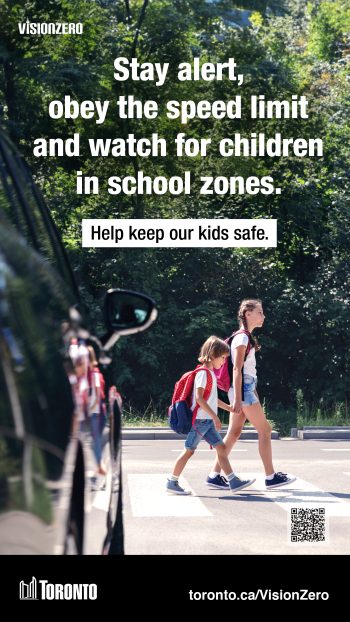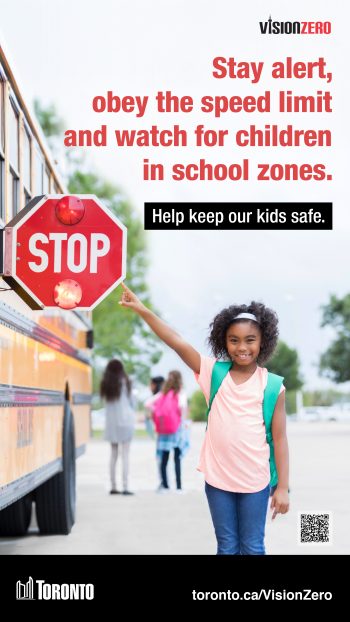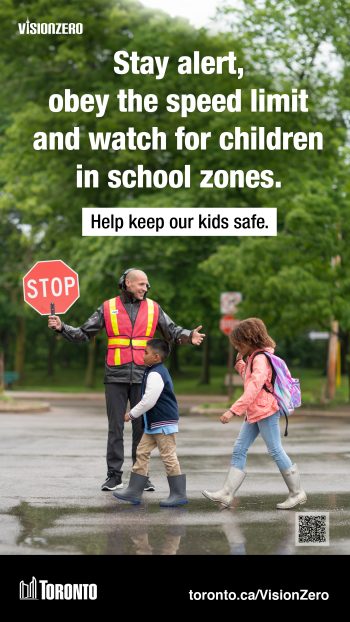
The return to school in September marks a significant uptick in road user activity across the city, particularly during morning drop-offs and afternoon pick-ups. This underscores the need for heightened vigilance and adherence to road safety measures.
The City of Toronto’s Vision Zero back to school road safety campaign reminds road users to stay alert, obey the speed limit and practice extra precaution as they travel from A to B.
As students return to class and always, help keep our kids safe. Stay alert, obey the speed limit and watch for children in school zones.



Digital transit shelter ads as part of the City’s 2024 public education campaign.
Explore past public education campaigns related to back to school road safety on the City’s Educational Campaigns & Outreach page.
The City continues to implement several Vision Zero Road Safety Plan actions, programs and initiatives to protect students, parents, guardians and teachers on Toronto’s roadways.
The School Crossing Guard Program: Throughout the school year, 879 school crossing guards are placed at intersections across the city to help children safely cross the street and remind people driving of the presence of children at key intersections. The City’s School Crossing Guard program is the largest of its kind in Canada.
School Safety Zones: A designated stretch of roadway that features School Safety Zone signage, pavement markings and speed stencils, flashing beacons, driver feedback signs and more. The City has installed School Safety Zones at 565 schools around Toronto and aims to install 80 more by the end of 2024. Learn more on the City’s Safety Zones webpage.
Automated Speed Enforcement (ASE): Automated Speed Enforcement is installed in Community Safety Zones across the city. Currently, 75 cameras are in operation (three per ward), with a combination of mobile units that rotate every three to six months, and permanent cameras which are pole mounted. The location changes allow the City to address a greater number of safety concerns and have a more impactful deterring effect. Tickets are issued to vehicles travelling at speeds greater than the posted speed limit. Automated Speed Enforcement aims to increase road safety, reduce speeding and raise public awareness about the need to slow down and obey posted speed limits.
Active and Safe Routes to School: The Active and Safe Routes to School program is a partnership between the City of Toronto, Toronto District School Board and the Toronto Catholic District School Board. The program delivers School Travel Planning to schools, which is a community-based model for addressing barriers to and incentives for active school travel.
Geometric Safety Improvements: Modifications to the geometry of intersections are made at hundreds of intersections across the City each year. Providing positive guidance to road users through road design is known to be one of the most effective ways to improve road safety. These changes include measures such as curb radii reductions, truck aprons, speed humps, raised crosswalks and intersections, curb extensions and intersection realignment. Learn more on the City’s Geometric Safety Improvements webpage.
Police Monitoring: The Toronto Police Service intensifies monitoring around schools, focusing on illegal parking, speeding and distracted driving to ensure a safe environment for students. This includes specific enforcement actions during the back-to-school period.
For more information about each of the safety measures listed above, explore the City’s Safety Initiatives or Vision Zero Road Safety Plan webpages.